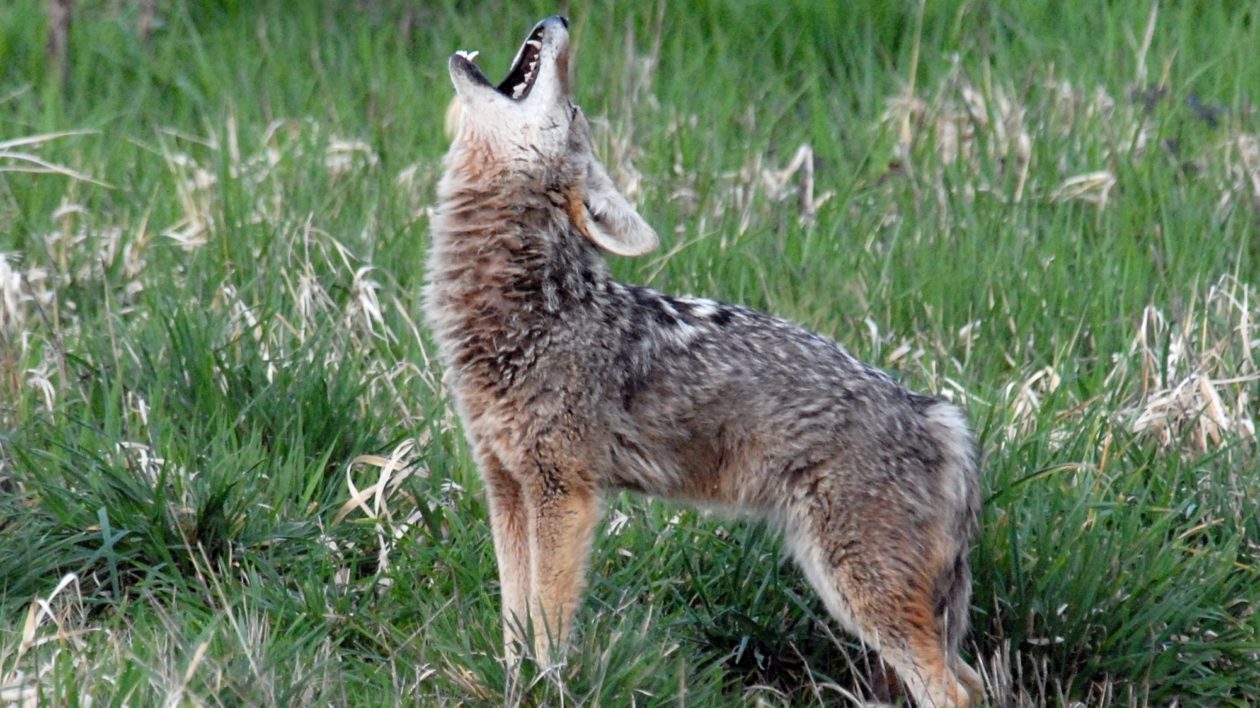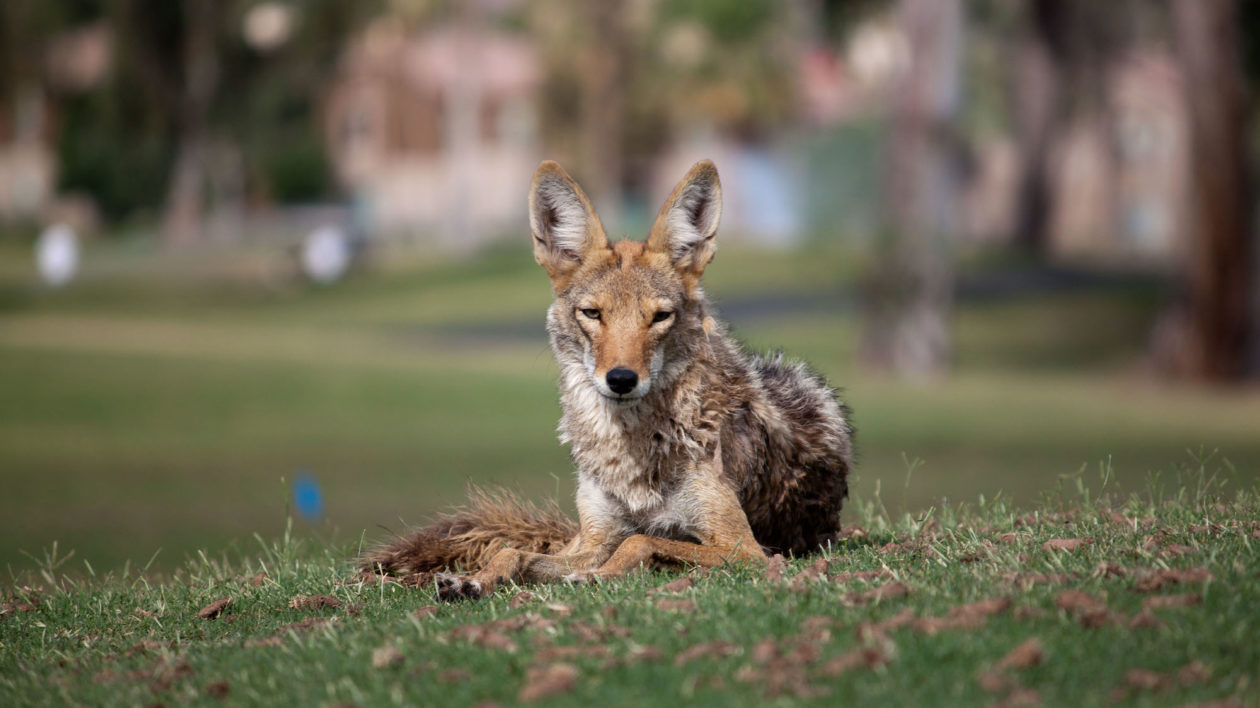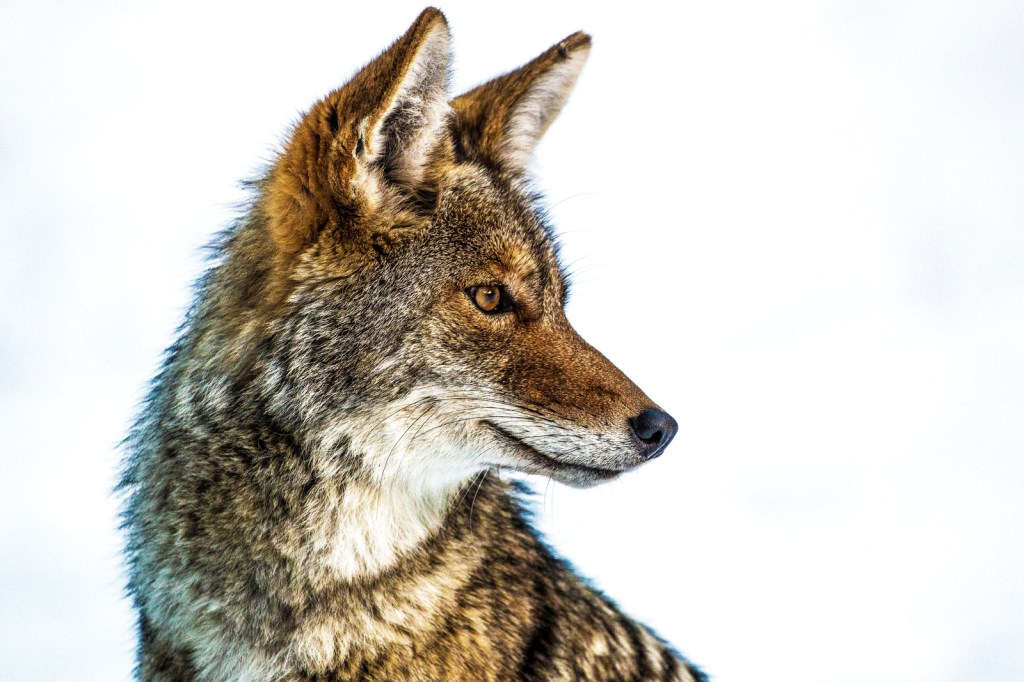I stepped outside last night to take some glass bottles to the recycling bin. The evening was clear, cold and seemingly silent. I hurried with my task, no wanting to linger in the chill. And then a howl rippled through the air. Coyote. The sound echoed through the neighborhood, carrying clearly from a nearby hillside.
I stopped and enjoyed the vocalizations. The long howls were interspersed with sharp yips, sounding like multiple animals. It lasted for several minutes.
I never tire of that sound, no matter how many times I hear it. And this time of year, I enjoy the coyote concert frequently.
Coyotes are one of the most vocal mammals. And they’re also now found widely, so if you live in North America, there’s a good chance that you have some roaming near you.
You can hear them at any time of year, but you may notice increased activity in February and March. And, if you’re like me, you’ll find the howling particularly resonant on a cold winter’s night. Here’s what’s going on.

The Pair Bond
Quite simply, it’s breeding season. While the exact timing varies, depending on geography, coyote breeding season generally occurs between late January and March. Coyotes are generally monogamous, forming strong pair bonds for several years. Some researchers state that the coyotes will remain together until one of the pair dies.
Coyotes are also territorial. The pair howls and yips to let other coyotes know that they have an established territory and not to intrude.
Coyote researcher Brian Mitchell describes the sounds you’re likely to hear at this time of year:
“Group yip-howls are produced by a mated and territorial pair of “alpha” coyotes, with the male howling while the female intersperses her yips, barks, and short howls. “Beta” coyotes (the children of the alpha pair from previous years) and current year pups may join in if they are nearby, or respond with howls of their own.”
Mitchell also notes that other nearby pairs may then respond, announcing their own territories. At such times, it can sound like a cascade of howls across the landscape.
According to Mitchell, this is not the only time of year that coyotes establish their territorial boundaries. The pups are born later in spring, and will form a loose family group. A pack of coyotes howling is an iconic sound of the American West, and it likely serves dual functions. Mitchell writes:
“The group yip howl is thought to have the dual purpose of promoting bonding within the family group while also serving as a territorial display. In other words, the coyotes are saying “we’re a happy family, and we own this turf so you better keep out.” In a sense, the group howls create an auditory fence around a territory, supplementing the physical scent marks left by the group.”

Song Dog
Howling may be the most recognizable coyote vocalization, but these canids actually have a wide repertoire of sounds. (One of the animal’s more endearing nicknames is “song dog”). Researchers generally identify 11 vocalizations that serve a variety of functions, from alarm to warning to socialization.
There is much we don’t understand about the coyote’s calls. Their “language” is likely far more complex than we can comprehend. Researchers like Mitchell note that coyotes have accents that vary geographically and even among family groups, much like humans. And coyotes can recognize another coyote by its distinctive call.
Even though coyotes are one of the most common and adaptable predators in the world, there is much we don’t understand. And there’s also a lot of contradictory information – and complete nonsense – written about coyotes.
There are two reasons for this. Coyotes are relentlessly persecuted throughout their range. A lot of people kill or attempt to kill coyotes, and oftentimes they present their own opinions as fact.
For instance, people often grossly overestimate the number of coyotes in an area. When a couple of coyotes begin calling, their sounds can vary rapidly in pitch and sequence, which can sound like a lot more coyotes than actually are there. Coyote howls often echo against hillsides, compounding the confusion.
This actually may provide a benefit to coyotes. As they establish their territory, sounding like a big pack may deter other coyotes from entering the territory.
I have often heard local hunters describe areas “absolutely overrun with coyotes,” based solely on the howling they’ve heard. Most likely, they were fooled by just a few animals.

A Flexible Lifestyle
I suspect there is another reason for a lot of the contradictory information about coyotes and their behavior. It’s because coyotes behave differently depending on habitat, interactions with humans and other factors.
Coyotes are one of the most adaptable predators. They are found in the Idaho wilderness near my home, but also can live in the midst of large cities like Chicago and Los Angeles. They live in farm country, in suburbs and in urban parks.
The reason that they can thrive in so many different habitats is that they are very flexible and adaptable. They will change their diet and their habits to fit the environment.
So a coyote’s territory and pack bonds are likely different on the public lands of the Rocky Mountains than they are in a suburban neighborhood.
One of the differences some researchers have recognized is that urban coyotes likely vocalize less. I live in an area surrounded by a large wildlife management area and a river greenbelt. I hear coyotes regularly. If you live in a city, you may not hear coyotes as much – but that doesn’t mean they’re not there. They have just found it easier to survive by being quiet.
If you do happen to find yourself in some wide-open spaces this month, step outside in the night and have a listen. You may enjoy one of the great sound shows in nature, the chorus of yips and howls. The coyote survives and thrives despite us, and its howling serves as a reminder to the wildness still in the world.




I live in Santa Cruz, CA – technically – the Live Oak area, along a riparian corridor. Yes, there a coyotes there. I hear the howling, and yips – so your comments helped me to understand how many this may mean – 1, several, babies, etc.
I have seen the large coyote 2 times – once walking my dog at night, about 10 pm – on the other side of the street – running back to the green belt area. And, a second time, at the bottom of the green belt where there is a stream. Others, have seen several on the path in the back of our HOA, along the path. I also see their scat many days and then know they were there recently.
Thanks for all your tips.
Note: I never let my dog out in the back at night, when they might be wondering around. My dog doesn’t understand wild animals.
A well written and informative article with attached beautiful photography. Appreciated information.
I heard our coyotes last night. The range of sounds that they emit are incredible. I love hearing them!
Thank you for the lite insight. Coyotes are an integral part of wildlife controlling mice rabbits and small to medium mammals. We live in Oklahoma and have lived with these song dogs knowing that they are just as much a part of the nature we love as the deer turkey eagles bear and fox. We know that we have to take precautions with our animals because Coyotes are very good at watching everything going on in there environment they watch and learn and will take advantage of any opportunity for an easy meal. So enjoy there songs but don’t hate them for doing what is natural. Simple precautions make them great neighbors.
Since we moved in next to 40-acre “Horse Hill” in Mill Valley, CA we’ve enjoyed the company of a series of coyote bands that hang out in the baylaurel groves, stream courses, and live oak clusters. Our two hunters, Journey and Brady have been trained to tolerate their canid brothers and sisters. Last month a new character appeared at dusk. “Mr. Cool” is middle aged, about 35 pounds and has a beautiful rust , gray, and tan coat. His nonchalance in our presence led to the name Mr. Cool. He joins his predecessors “Stella,” and “Yoda–whose ears stuck out like the Star Wars character. We keep our distance and adhere to the maxim “A fed coyote is a dead coyote.” Camilla Fox of Project Coyote stops by from time to time with updates on her crusade against killing contests.
Thank you for answering the question I have always had – do different groups have different accents. The ones at Carlsbad Cavers National Park around the visitors center sound decidedly different from the ones around Ft. Stanton Cave near Capitan, NM. Not being around them that much, and not being with a group of scientists who study coyotes (they are cavers, cartographers, microbiologists, geologists, etc), no one was willing to hazard a guess, nor particularly interested.
Fritzi Hardy
Albuquerque, NM
Interesting and true evaluation. We lived in southern .ca where we often heard and saw coyote. Beautiful animals, social with their kind and so vocal. America needs to know them. They are not a threat.
Coyotes and wolves are hightly endangered and need endangered species act protection somehow, some way.
Coyote’s are not an endangered species!!! They should be culled. They are not native to coastal California [possibly to all of the state] and should be exterminated here; just as non-native vegetation should be eliminated. Like the Ravens and crows they are a forbording of what trends are detrimental to the abundant life, which flourishes here more than anywhere else I have ever seen. I know these things are true for I know what was here when I was 1-40 years old. If you weren’t here then you would be ignorant of the facts; since not much research happened in the early and mid 1900s. Humans don’t live long enough to bare witness to such things; but I have witnessed these facts personally and I say to you, that I have seen the all to rapid change in my life time. The major cause is Human Beings, who think it is cute to introduce non-native species to all areas outside their native habitat. Like, there are no turkeys hear on the coast; so I’ll bring them out west to coastal California. How cool is that [Bull Crap]?
Coyotes are not endangered (and there is no place in the article where this is stated). Coyotes ARE native to California. Just because something is not present for 40 years does not mean it was never native to a place.
I live in the country and hear coyotes daily. In fact, when they are vocal, my dogs run out the doggie door and tend to wander off for a bit. We have witnessed them chasing the coyotes and then the coyotes turn and chase them. I fear that one day my dogs may not come back due to being lured in and attacked, but I am not one of those people that just want to kill coyotes for sport. I am an avid animal lover. People say how nasty coyotes are with rabies and mange etc. We rarely see them but do occasionally and it does seem that their numbers are rapidly increasing but I believe it is the echoing of their calls etc like explained. They recently held one of their “coyote hunting derbies” in the area and it breaks my heart to know that they are called in to their senseless death for sport.
Loved reading this. I hear coyotes very often in my back fields and yes, it sounds like there are many of them.
Thanks,
Lou
I live in Southern California and it seems people either love the coyotes or hate them! Some neighbors were going to call in predator hunters to kill the group we have heard “singing”. So many people think they attack children and that is simply not true. I wish people could learn to respect wildlife and not want to kill everything!!
Thanks. I enjoyed the coyote blog. I’ve grown up hearing coyotes and still thrill to hearing that wild voice after 79 years of yips and howls
Coyotes are newcomers to my property. Since they arrived I have noticed the disappearance of smaller animals, like skunks, raccoons even squirrels and I miss them. What are my options?
Ingrid Greenfield
In my suburban neighborhood animal control authorities try to control coyote population by shooting them. That management style seems dangerous in a semi urban area and doesn’t really seem to effect the population. I see coyotes every day, so I am guessing that more just move into the territory. Would it possibly be more effective to trap and neuter the existing coyotes for re release so they could control the population in their territory and not add more to the density?